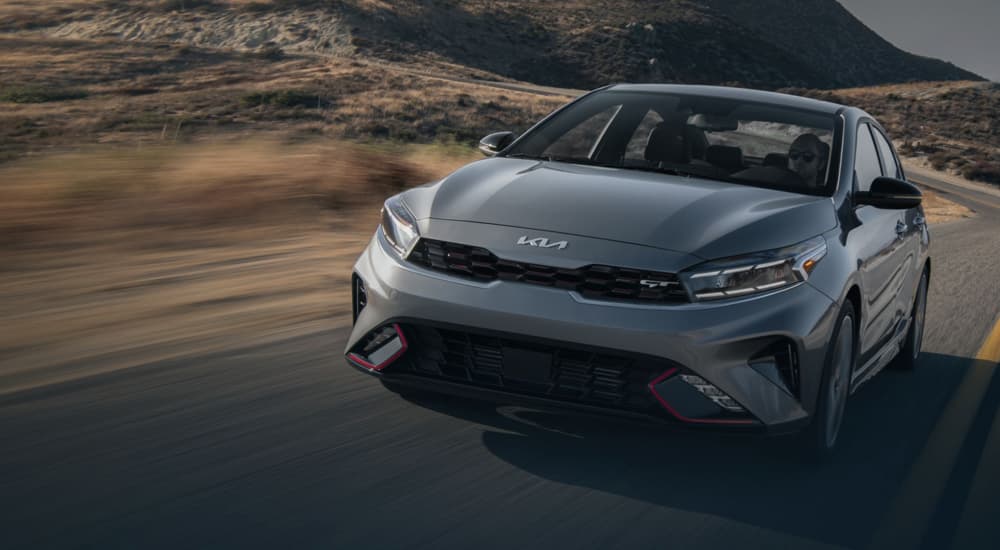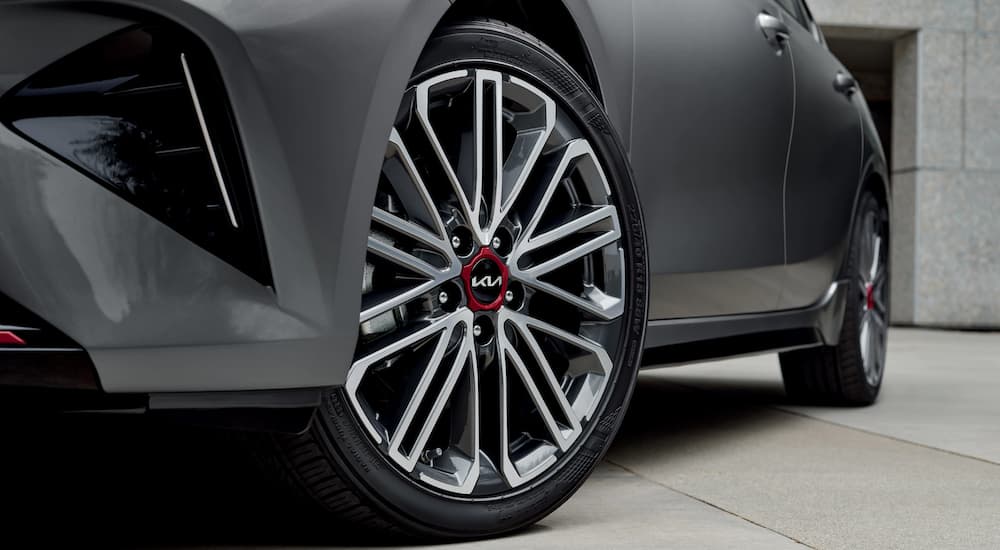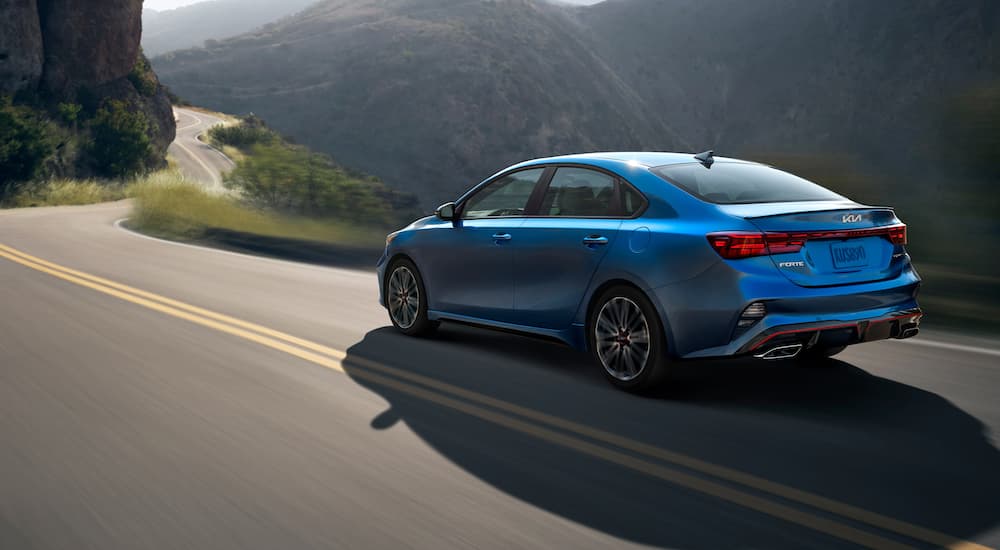We sometimes polarize sedans and sports cars. It can be helpful to have distinctions and classifications, but we often let sedans wallow in the category of mere “commuter” vehicles while sports cars get all of the attention and have all of the fun. Of course, the line between sedans and sports cars is not always a great one, and there is a decent amount of crossover between the two. Some sedans are purchased merely for functional purposes, to handle a daily commute, but some, like the Kia Forte, are designed to hold their own in the performance and design sectors.
The difference between these two types of sedans is often found in the engine. Many vehicles, including the Forte, allow you to choose between two or more engines, and this can drastically change the performance and driving experience. A driver looking for a Kia Forte may want a commuter that offers a fuel-efficient drive, while others might be looking for a sedan with a little extra pep than a model like the Corolla will provide. However, a Forte is not a Forte is not a Forte. You may find a Kia Forte for sale, sign, and drive away only to realize that the car doesn’t perform as well as you’d hoped. Why? Because you didn’t understand the different engine options. Most car enthusiasts understand how big of a difference your powertrain can make, but it’s interesting to really look at how a vehicle changes from one engine to the next.
Choose Your Engine
What is a car without an engine? It’s basically a skeleton. The engine is what gives the car its on-road personality and is one of the biggest determining factors for buyers seeking a performance-oriented vehicle. It’s always exciting to find out that a vehicle offers more than one engine option, but that makes it even more important to educate yourself on the differences. Some cars offer all different engines on all trim levels but change which one is standard? Advertising can be tricky to navigate, and it’s important that drivers aren’t swept away by clever phrasing. Get the whole picture!
The 2023 Forte offers five different trims: LX, LXS, GT-Line, GT, and GT Manual. LX, LXS, and GT-line provide the same engine: the 2.0-liter four-cylinder. The GT and GT Manual have the 1.6-liter turbocharged four-cylinder. If you’re an engine enthusiast, you may have some educated guesses as to which engine provides the higher specs. To those of you that may not be as engine-savvy, though, this can be a confusing choice to navigate because one is bigger than the other by 0.4 liters (and our American minds usually tell us that bigger is better!) while the other includes a very important word: turbocharged.
Which Engine Is Better?
So, which engine is better? Well, typically, a larger engine means more fuel burned, which bodes well for performance. So, with a standard four-cylinder engine, bigger is indeed better. Turbocharged engines, however, take a different approach. When the average driver hears “turbocharged,” they may think of a jetpack or some kind of futuristic high-speed flying car. This image is both right and wrong. It’s not a jetpack, and unfortunately, the Kia Forte cannot fly (not yet, at least), but they have the right idea of the engineering that is employed.
In a turbocharged engine, the air flows into the cylinders, meaning that the literal molecules are crammed tightly together. Tightly packed air means that more fuel can be added per unit, and more fuel per unit means greater power. This efficient airflow makes for a more profound internal combustion process and overall greater efficiency. Because a turbocharged engine is able to pack more fuel per unit, these engines are smaller than standard engines but typically offer greater performance specs.
If literal engine capacity is what is important to you, then bigger is better, and the 2.0-liter will be your best bet, but if you’re looking for the thrills of a sports performance car, then turbocharged is the way to go. While the 2.0-liter offers 147 horsepower and 132 pound-feet of torque, the 1.6-liter turbocharged offers 201 horsepower and 195 pound-feet of torque. You wouldn’t think that a smaller option would offer a difference in performance of that magnitude, but the turbocharger makes it possible. If raw performance is what you’re looking for, there’s no question, the turbocharged option is the way to go.
Performance vs Efficiency
So, if it has lower horsepower, what’s the benefit of the 2.0-liter? Well, that’s where it gets interesting. Increased performance is fantastic, but if raw fuel efficiency is more important to you, then the 2.0-liter has a leg up. The 2.0-liter offers an EPA-estimated fuel economy of 30 MPG in the city, 41 MPG on the highway, and 34 MPG combined. Those are some excellent numbers, especially for a non-hybrid sedan.
The 1.6-liter turbocharged engine has an EPA-estimated economy of 27 MPG in the city, 35 MPG on the highway, and 30 MPG combined with the automatic transmission. That’s not bad at all and is competitive with the ratings of most other sedans in the Forte’s class, but it isn’t quite on the same level as the 2.0-liter. The lowest ratings come when you get the 1.6-liter with the manual transmission, and even that is excellent at 22 MPG in the city, 31 MPG on the highway, and 26 MPG combined.
“Efficiency” is one of the buzzwords in the current automotive market. With gas prices constantly in flux, having an engine with good fuel economy is a must. Both of the engine options for the 2023 Kia Forte deliver. If you want the most mileage out of your gas tank, then the 2.0-liter is the engine for you; however, if you can’t quite let go of the extra horsepower, you won’t be too disappointed with the fuel consumption of the turbocharged 1.6-liter.
Shifting the Experience
Different engines focus on providing different types of driving experiences. However, some drivers are less focused on driving and are more focused on the experience of driving. If you’re focused on looks and technology over performance, then you’ll want to focus less on engine choice and more on trim packages since that opens up the doors to exciting design cues. For those focused on optimizing sporty design rather than a sporty engine, working your way up the trims gives access to better exterior and interior features, including the LXS trim’s 16-inch alloy wheels or the sport seats in SynTex and cloth trim in the GT-Line.
The GT trim is where you’ll find better looks and the better engine. However, the most exciting trim of all is the one that literally shifts both driving and the experience: the GT Manual. Driving stick is fun; it keeps you more engaged in the drive, and it requires you to cultivate the skill of driving in a more exciting way. Because it is still the GT trim, it comes with the 1.6-liter turbocharged engine, meaning more horsepower. So, throw a manual transmission on there and you’re in for a fun drive.
The Forte’s Forte
Kia is known as an efficient commuter brand. The Forte is a manifestation of the brand’s efficiency coupled with its push into a more performance-ready space. The Forte is showing us just how dynamic your everyday sedan can be. It finds the balance between performance secs and fuel efficiency, allowing drivers to have both a car for errands and a car for fun all in one package.






